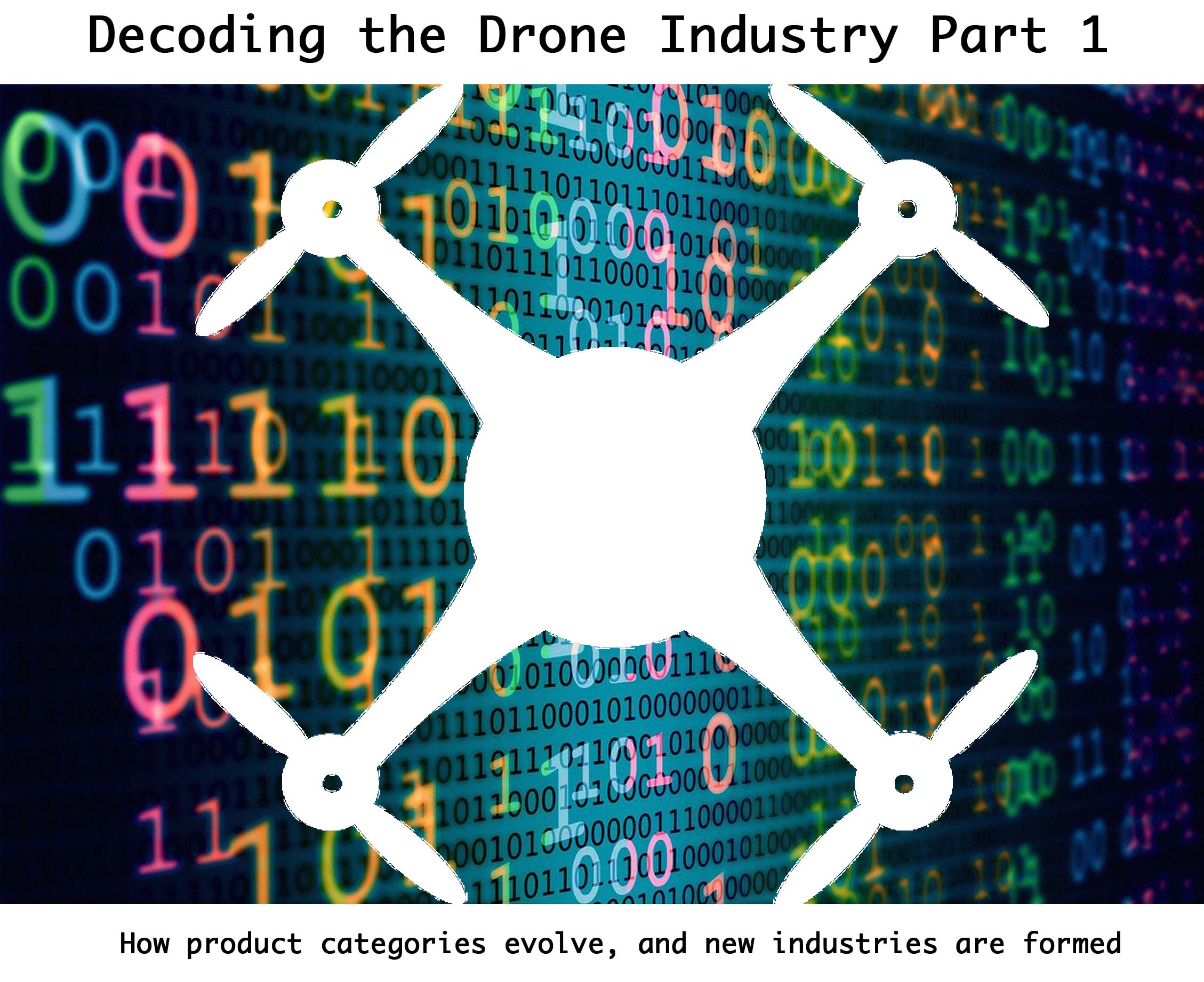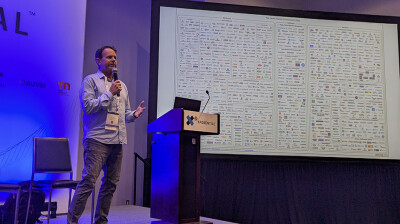A market represents the demand side of economic activity (buyers). An ‘industry’ represents the supply side of economic activity (sellers). The intent of Part – 1 is to introduce the drone industry to the research by Professors' Fernando F. Suarez, Stine Grodal, and Aleksios Gotsopoulos. Through this research, we gain a much clearer comprehension of how new product categories emerge and how new [technology] industries are formed. While Part – 1 may feel slightly academic, it sets up the context for Part 2, which provides an insightful perspective of the drone industry. Part – 2 applies this research to the drone industry along with a novel theory [of my own] describing its evolution. The intent is to instigate healthy conversations within the drone industry.
Every company small or large entering into a nascent industry, including Venture Capital (VC) and Corporate Venture Capital (CVC), should understand the research highlighted in this article.
_____________________________________________________
Introduction to the research
The research by Professors' Suarez, Grodal, and Gotsopoulo, was a multi-year research program to understand the role of categories in industry dynamics by studying the evolution of the Smartphone industry. The original research was published in 2013. A condensed version was published in 2015, titled; “Mastering the ‘Name Your Product Category’ Game.” While the title of this paper might not grab your attention, keep in mind that the entire drone industry is undergoing these same dynamics.
My first experience with product category labels
My first in-depth experience with product categories started in 2008 while working for Constant Contact (CTCT). CTCT went public in October 2007 on the success of their Email Marketing product. Their second product called "Online Survey," also released in 2007 was built in-house. For their third product, CTCT decided to take the acquisition route.
Through customer research, they identified increasing demand to assist small businesses to plan, manage and track their events using online software. This need led to the acquisition of my software company in 2008—Constant Contact’s first acquisition!
"Category confusion" can lead to rejection from loyal customers
Right after the acquisition, one of the first strategic initiatives we embarked on was to determine the product category label. I was lobbying for the phrase "Event Management" because this was the label for the industry. At that time, CTCT thought the label was too enterprise-like for its small business audience, which was the majority of their customer base.
Based on a series of customer forums, we narrowed down the list to three labels: "Event Management," "Online Registration," and "Event Marketing." We settled on "Event Marketing" because there was parity with the existing label of "Email Marketing."
CTCT’s main objective was to cross-sell the Event Marketing product to existing Email Marketing customers, who were managing events manually, mainly using spreadsheets. One of the unintended consequences of choosing the category label of Event Marketing, was that it confused existing Email Marketing customers into thinking it was just another fancy email template and not a different product.
Our cross-sell efforts were unsuccessful. In effect, we created a type of "category confusion" for existing Email Marketing customers. The two labels (e.g., Email Marketing and Event Marketing) were not distinct enough from each other for current customers. While other factors can contribute to this confusion (e.g., messaging, industry life cycle, etc.), it had mostly to do with the labels.
A thoughtful labeling strategy will lead to success
While we were doing a poor job of cross-selling into the customer base, we far exceeded the forecast of attracting new customers with their first purchase being Event Marketing. And even better, these same customers in-turn purchased Email Marketing (unaided). These first-time buyers of the Event Marketing product were not confused by the two different labels because of the product differences.
While the net result was positive, this experience highlights the importance of a thoughtful category labeling strategy.
NOTE: Once a few years had passed, we eventually changed the category name to the rightful label of ‘Event Management.’ The labels of Email Marketing and Event Management were divergent enough from each other to avoid any category confusion. Our cross-sell efforts were finally successful.
Exploring the research by Professors' Suarez, Grodal, and Gotsopoulo
The researchers extend the theory of Categorical dynamics by introducing two new concepts;
1. Dominant Category Label – “A dominant category label reduces the uncertainty and confusion surrounding the meaning of a new type of product, making it clearer to customers and producers what the new product is for and how it should be used.”2
2. Dominant Design – “The dominant design is a specific product architecture that is quickly adopted by the producers in the industry”2
Understanding a nascent Industry
In a nascent industry, there is a proliferation of new companies and category labels. The meaning of these labels is often fuzzy and unclear, hence potential buyers take a “wait and see” attitude. This explains why first-movers are typically disadvantaged. Entering a new market entails uncertainty, and first movers bear the risk of failure if the market does not develop as expected.
Once the dominant category label emerges, the demand will begin to grow. As an industry matures, the research shows the optimal time to enter the market is after the dominant category label has been established and before the introduction of the dominant design.
Understanding a mature industry
The industry has settled on a dominant category label and dominant design. At this point, the number of companies has been consolidated. Consumers can expect products in the same category to have a common feature set, meaning there are “rules of membership” for the category.
If you purchased a Smartphone without GPS navigation and social networking, you would likely return the item. These are all expected features of the device. If the feature is not included, the seller would pay a penalty because of the “rules of membership” for the category.
The evolution of the Smartphone industry
 As shown in Figure – 1, a new industry will bring about a proliferation of new companies and category labels.2 There were more than 200 category labels in describing the early Smartphone devices. Examples included "Pocket Computer," "Camera Phone," "PDA Phone," "Gaming Device," and many more. Ericsson is credited with creating the dominant category label, "Smartphone."
As shown in Figure – 1, a new industry will bring about a proliferation of new companies and category labels.2 There were more than 200 category labels in describing the early Smartphone devices. Examples included "Pocket Computer," "Camera Phone," "PDA Phone," "Gaming Device," and many more. Ericsson is credited with creating the dominant category label, "Smartphone."
As the industry matures, one label emerges as the dominant category label. The research states that the affirmed label is “collectively created and socially negotiated.”2 It can take years for the dominant category label to take shape.
“An ideal window of opportunity for market entry exists in the time period between the introduction of the dominant category label and the introduction of the dominant design; at that point, the dominant category label starts to shape what is expected in the product category—and thus reduces uncertainty for both customers and producers—but a dominant design for fulfilling those expectations has yet to emerge.”2
As the industry matures and reaches a peak, it begins to consolidate the number of companies – known as the industry life cycle. This consolidation demarcates the emergence of the dominant design, which is a specific product architecture or feature-set that is quickly adopted by the industry.
Labeling strategy
As discussed earlier, a company’s labeling strategy can have tangible performance implications on the business. A labeling strategy is far more than just picking a word or groups of words. The label typically combines the type of products or services being offered within the name. In an emerging category, the right label can actually stimulate market adoption.
Here are some simple guidelines:
- When entering a mature category, adopt the label for that category.
- When entering a nascent category, if an existing label represents your product, adopt that label. This often requires some research to see how your competitors are talking about their products. The research suggests to consider a hedging strategy by associating your product across several category labels till the dominant label emerges.
- If you need to create a new label, the research suggests that the label should be both ‘novel and familiar.’ Distinctive enough to attract attention, yet familiar enough to convey how it will be used. Labels must balance the inherent tension between novel and familiar.
Inferences
Based on my own years of experience in applying this research, I’ve derived 6 inferences. In Part – 2, I provide examples for these inferences as applied to the drone industry.
1. An industry requires at least one dominant category label, ideally having a dominant design.
An industry with a dominant category label and dominant design is firmly rooted in its market because there are “rules of membership” required to be part of the category. Consumers have expectations as to the capabilities of products in the same category. Products that do not conform to these rules will face penalties in the market.
An industry with a dominant category label and without a dominant design demonstrates industry-like characteristics but is less rooted in its market. There is demand for these products, but the capabilities may well diverge from company to company in the same category.
(E.g. Sales Enablement, Social Networking, etc.)
2. An industry can have more than one dominant category, each one, ideally having a dominant design.
Industries can intersect with multiple categories based on various criteria such as the types of products or services they offer, the markets they serve, the technologies they use, and their regulatory environments. This is why industries are often complex and multifaceted. I like to refer to the top-level label for an industry containing multiple categories as the "umbrella" label.
(e.g., Automobile industry includes Electric Cars, Minivans, Hybrids, etc.)
3. The brand that becomes synonymous with the dominant category label is a ‘market maker.’
When you hear the phrase "Electric Car," "CRM," and "Smartphone," you may think of Tesla, Salesforce, and Apple. There are references on the internet to the term "Category-King," which I believe is appropriate. These companies often have a dominant market share and are the architects of their respective markets.
4. The term ‘Product-market fit’ should only be used for an emerging category.
The phrase "product-market fit" (PMF) should be reserved for companies in an emerging category. It represents the broader alignment between a product and its target market. PMF signifies an early market and that the product has the potential for long-term success. Once the dominant design exists, "product-category fit" (PCF) is the appropriate term. It refers to the alignment between a product and its designated category within the market. PCF facilitates easier marketing and sales efforts, as the product naturally fits into an existing category that customers already understand and are interested in. It helps to ensure that a product is positioned and competitive within its specific market.
5. Well-known brands can bypass the typical industry dynamics, but it comes at a price.
Well-known brands can fast-track the typical industry dynamics by creating the dominant category label at the inception of the category. Other companies entering into the category then accept the label on face value but the meaning of the label is not well understood. This leads to prolonged confusion for its intended market, due to the industry's own uncertainty about its precise meaning. Given that traditional industry dynamics have been sidestepped, cross-industry collaboration is vital to give the category label its definitive meaning and to clearly define the category. It’s quite possible this anomaly may have an adverse effect on the dominant design. (e.g., UTM)
6."
In an emerging category, I would recommend competitors getting together and collaborating on the dominant category label and its ultimate meaning. To avoid the pitfalls of #5, it's critical to make sure the label is well defined. Remember, in a nascent market, the labels are still relatively shallow in meaning, so this approach would eliminate the confusion for the consumers. These efforts could accelerate the typical industry dynamics for a particular category.
NOTE: I reference the term ‘category collusion’ because it is novel, but there is nothing illegal about competitors collaborating on the dominant category label and its meaning. In theory, competitors could also collaborate on the dominant design, but I believe this is likely unrealistic.
Nascent industry v. Mature industry
By blending Categorical Dynamics with Industry Life Cycle theory and Crossing the Chasm, we gain a comprehensive understanding of value creation and capture in an emerging industry and its market. The tables below demonstrate the continuity across the different theoretical frameworks between an industry and its market at varying stages.
Nascent industry
Industry Life Cycle | Categorical Dynamics | Crossing the Chasm |
Startup stage. | The dominant category label has yet to be established. The labels are still relatively shallow in meaning. There is no dominant design. PMF is the measure for success. | The Innovators and Early adopters are the first groups to adopt these new products. They like new technologies and are risk friendly. However, breaking into the Main Street market is difficult because the category is yet to be defined, the product benefits are unclear, there are no trusted sources for referrals, and reliability is still a concern. There is still lots of risk for the Main Street market, hence these buyers take a ‘wait and see’ attitude. |
Mature industry
Industry Life Cycle | Categorical Dynamics | Crossing the Chasm |
Transitioned past the Startup and Growth stages into the Maturity stage. | The dominant category label has been established. The dominant design has taken shape. Consumers have expectations as to the capabilities of a product from different companies in the same category. PCF is the measure for success. | The industry has crossed the chasm into the Main Street market and beyond. The category label is defined. A standard exists. The features and benefits of the products are well understood and proven out. Referrals are possible. Complete solutions are available. |
What's next?
The rapidly evolving drone market is marked by significant complexity and uncertainty, necessitating analytical tools to better comprehend the state of the industry. Categorical dynamics is a theory within organizational sociology that focuses on how categories, influence the behavior of organizations within an industry. By applying the research summarized in this article, organizations can accelerate the commercial viability within their category.
In Part – 2, I propose that, over the past five decades, the only industry to rival the drone industry in terms of the breadth of new product categories is the Personal Computer (PC) industry. In fact, the drone industry behaves very much like the PC industry in its evolution. This resemblance underscores the drone industry's development, echoing the PC revolution and heralding a new era of technological innovation.
I also apply Categorical Dynamics to the drone industry in Part-2. The implications are profound and revealing!
REFERENCES
1. Fernando F. Suarez | Stine Grodal | Aleksios Gotsopoulos, Perfect timing? Dominant category, dominant design, and the window of opportunity for firm entry, Wiley Online Library, 26 December 2013
2. Fernando F. Suarez | Stine Grodal, Mastering the ‘Name Your Product Category’ Game, MITSloan Management Review, Winter 2015
NOTE: Dedicated to Chris Kucera, a visionary in our industry and someone I deeply admired.
















Comments